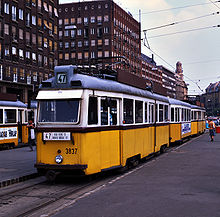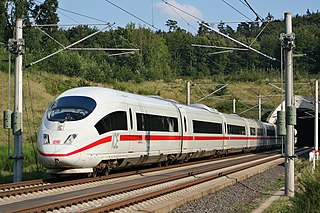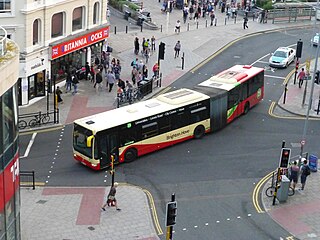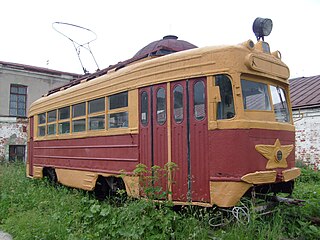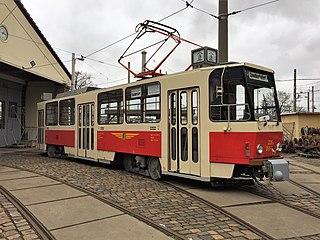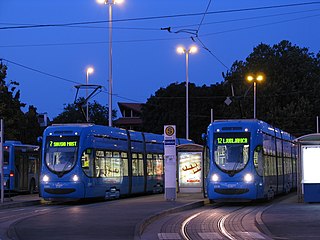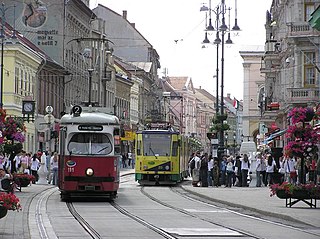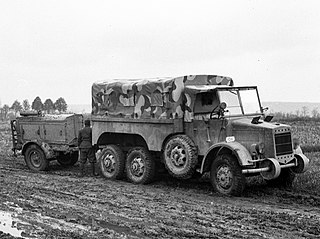This article does not cite any sources .(May 2016) (Learn how and when to remove this template message) |
| Ganz UV | |
|---|---|
An UV tramset on Budapest's line 47 in 1992 | |
| In service | 1956–2007 (~51 years) |
| Manufacturer | underframe and bogies: Ganz Vagon- és Gépgyár Budapest, carbody: Rába Magyar Vagon- és Gépgyár, Győr, traction system: Klement Gottwald Villamossági Gyár Budapest, |
| Replaced | Ganz TM Stuka |
| Constructed | UV1: 1956–1957 UV2: 1958–1959 UV3: 1959–1961 UV5: 1962–1965 UZ: 1958–1959 |
| Entered service | 1956 (62 years ago) |
| Refurbishment | 1993–1994 (20 UV into MUV) |
| Scrapped | 1990s–2007 (11 years ago) |
| Number built | UV1: 50 UV2: 100 UV3: 125 UV4: 0 UV5: 100 UZ: 2 total: 377 |
| Number in service | 0 |
| Number preserved | at least 11 cars (multiple variants) |
| Number scrapped | n.a. |
| Formation | MC, [lower-alpha 1] MC+TR, [lower-alpha 2] MC+TR+MC, MC+MC |
| Fleet numbers | UV1: 3200–3249 UV2: 3250–3349 UV3: 3350–3474 UV5: 3800–3899 |
| Capacity | 94 passengers [lower-alpha 3] |
| Operator(s) | Fővárosi Villamosvasút (FVV), Budapest, (1956–1967) Budapesti Közlekedési Vállalat (BKV), Budapest, (1968–2007) |
| Specifications | |
| Car body construction | UV1, UV2, UV3, UV5: steel, UZ: aluminium |
| Car length | carbody: 12,600 mm (41 ft 4 in) between couplers: 13,500 mm (44 ft 3 in) (UV1, UV2, UV3) 13,690 mm (44 ft 11 in) (UV5) |
| Width | 2,300 mm (7 ft 7 in) |
| Height | 3,100 mm (10 ft 2 in) |
| Floor height | 783 mm (2 ft 6.8 in) (midsection) 668 mm (2 ft 2.3 in) (end sections) |
| Entry | step |
| Doors | telescopic sliding doors, 3 per side UV1, UV2, UV3: 2+1+2 UV5: 2+2+2 |
| Wheel diameter | 670 mm (2 ft 2 in) |
| Maximum speed | 50 km/h (31 mph) |
| Weight | 19,750 kg (21.77 short tons) |
| Traction system | 4 × Ganz TA 1.18 initially in early cars: 4 × Ganz TA 1.12 |
| Power output | 4 × 50 hp (37 kW) (=200 hp (150 kW)) initially in early cars: 4 × 42 hp (31 kW) (=168 hp (125 kW)) |
| Auxiliaries | 24 V DC |
| Power supply | 600 V DC (except MUV cars) |
| Train heating | electric heating |
| Electric system(s) | 600 V DC from overhead line |
| Current collection method | pantograph |
| UIC classification | Bo'Bo'tr [lower-alpha 4] |
| Bogies | pivoting |
| Braking system(s) | electric, electro-pneumatic |
| Safety system(s) | proprietary tramset breakage sensing system |
| Coupling system | mechanical: Alemann-type trichterkupplung electrical: proprietary DC connectors |
| Multiple working | only with same type |
| Headlight type | incandescent light bulbs |
| Track gauge | 1,435 mm (4 ft 8 1⁄2 in) |
The Ganz UV (Hungarian pronunciation: [ˈɡɒnz ˈuːveː] ) is a series of tramcars which was manufactured by Hungarian companies Ganz Vagon- és Gépgyár ("Ganz Carriage and Machine Factory"), Rába Magyar Vagon- és Gépgyár ("Rába Hungarian Carriage and Machine Factory") and Klement Gottwald Villamossági Gyár ("Klement Gottwald Electric Factory"), which was the name of Ganz Villamossági Gyár ("Ganz Electric Factory") at the time of manufacturing. The UV tramcars have four main variants, all are four axle rail motor coaches with a Bo'Bo'tr axle arrangement, capable of operating as electric multiple units. The cars were manufactured between 1956 and 1965 in Budapest, and overall 375 regular units and 2 prototypes were made.

A tram is a rail vehicle which runs on tramway tracks along public urban streets; some include segments of segregated right-of-way. The lines or networks operated by tramcars are called tramways. Historically the term electric street railways was also used in the United States. In the United States, the term tram has sometimes been used for rubber-tyred trackless trains, which are unrelated to other kinds of trams.

Hungary is a country in Central Europe. Spanning 93,030 square kilometres (35,920 sq mi) in the Carpathian Basin, it borders Slovakia to the north, Ukraine to the northeast, Austria to the northwest, Romania to the east, Serbia to the south, Croatia to the southwest, and Slovenia to the west. With about 10 million inhabitants, Hungary is a medium-sized member state of the European Union. The official language is Hungarian, which is the most widely spoken Uralic language in the world. Hungary's capital and its largest city and metropolis is Budapest. Other major urban areas include Debrecen, Szeged, Miskolc, Pécs and Győr.
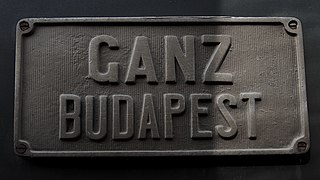
The Ganz Works or Ganz was a group of companies operating between 1845 and 1949 in Budapest, Hungary. It was named after Ábrahám Ganz, the founder and the manager of the company. It is probably best known for the manufacture of tramcars, but was also a pioneer in the application of three-phase alternating current to electric railways. Ganz also made ships, bridge steel structures and high-voltage equipment. In the early 20th century the company experienced its heyday, it became the third largest industrial enterprise in Kingdom of Hungary after the Manfréd Weiss Steel and Metal Works and the MÁVAG company. Since 1989, various parts of Ganz have been taken over by other companies.
Contents
The UV type designation resolves to U típusú távvezérelt motorkocsi ("type U remotely controlled motor coach"). The units are capable of controlling another unit of their type through proprietary 50-wire cables. The trams are also capable of sensing the breakup of the tramset with the use of a chain hanging between the cars; brakes are automatically applied if a chain is pulled out from its sockets. Two prototypes were made with aluminium carbodies, designated as UZ, [lower-alpha 5] these proved to be unsuccessful. In addition, in the 1990s, 20 UV cars were refurbished and they are referred to as MUV [lower-alpha 6] (modernizált UV, "modernized UV"). Planned to replace the pre-WWII design TM [lower-alpha 7] trams, with 377 units, the UV series became the most numerous type of tramcar produced in Hungary.

A prototype is an early sample, model, or release of a product built to test a concept or process or to act as a thing to be replicated or learned from. It is a term used in a variety of contexts, including semantics, design, electronics, and software programming. A prototype is generally used to evaluate a new design to enhance precision by system analysts and users. Prototyping serves to provide specifications for a real, working system rather than a theoretical one. In some design workflow models, creating a prototype is the step between the formalization and the evaluation of an idea.
The first car entered passenger service in 1956, and the type was ultimately decommissioned in 2007, after roughly 51 years of continuous service. UV trams became one of the symbols of Budapest, and had appeared in a number of Hungarian and foreign movies as plot elements. Two preserved, paired UV cars now annually serve as the city's so-called Christmas light trams in the festive season, decorated with white and blue LED lights.

Christmas lights are lights used for decoration in celebration of Christmas, often on display throughout the Christmas season including Advent and Christmastide. The custom goes back to when Christmas trees were decorated with candles, which symbolized Christ being the light of the world; these were brought by Christians into their homes in early modern Germany.
